|
|
Post by RickB on Jun 24, 2022 14:06:58 GMT -5
I healthy 4 to 5 inch vine. www.thetreecareguide.com/how-to-get-rid-of-poison-ivy-on-tree/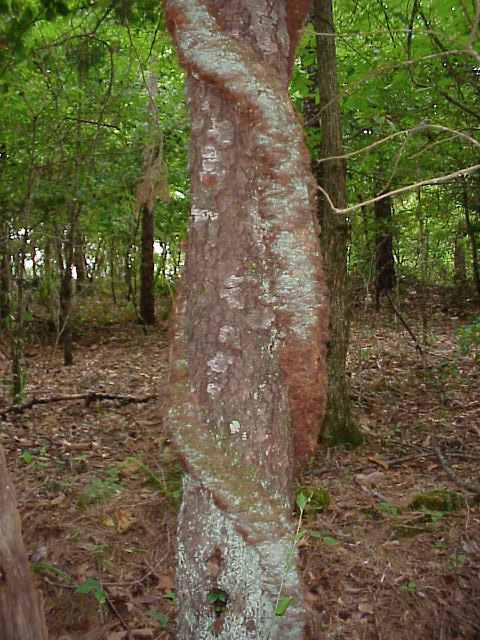 The way to kill it, the vine is soft and gives way to a machete easily. Chainsaw peppers you with poisonous particles unless using top side of blade so particles fly away from operator. 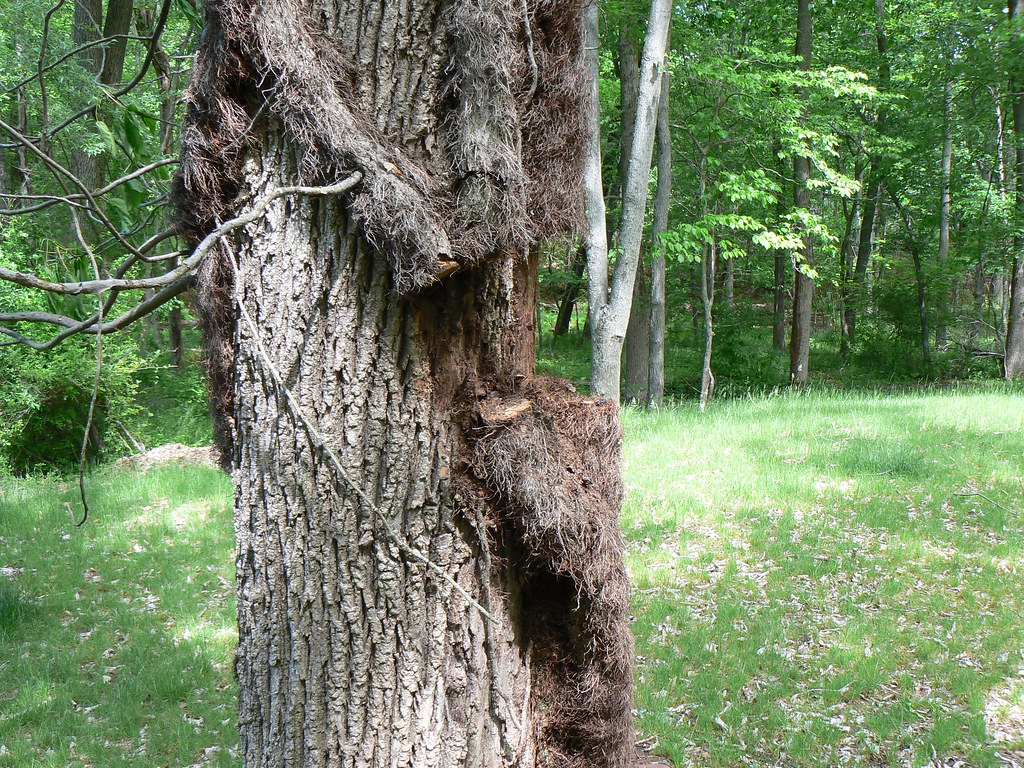 Winter view. Like I said it makes a great hedge either vertically or horizontally. Probably killed this tree. In this case dress heavily and get the chainsaw out. Good winter project. Note branches. 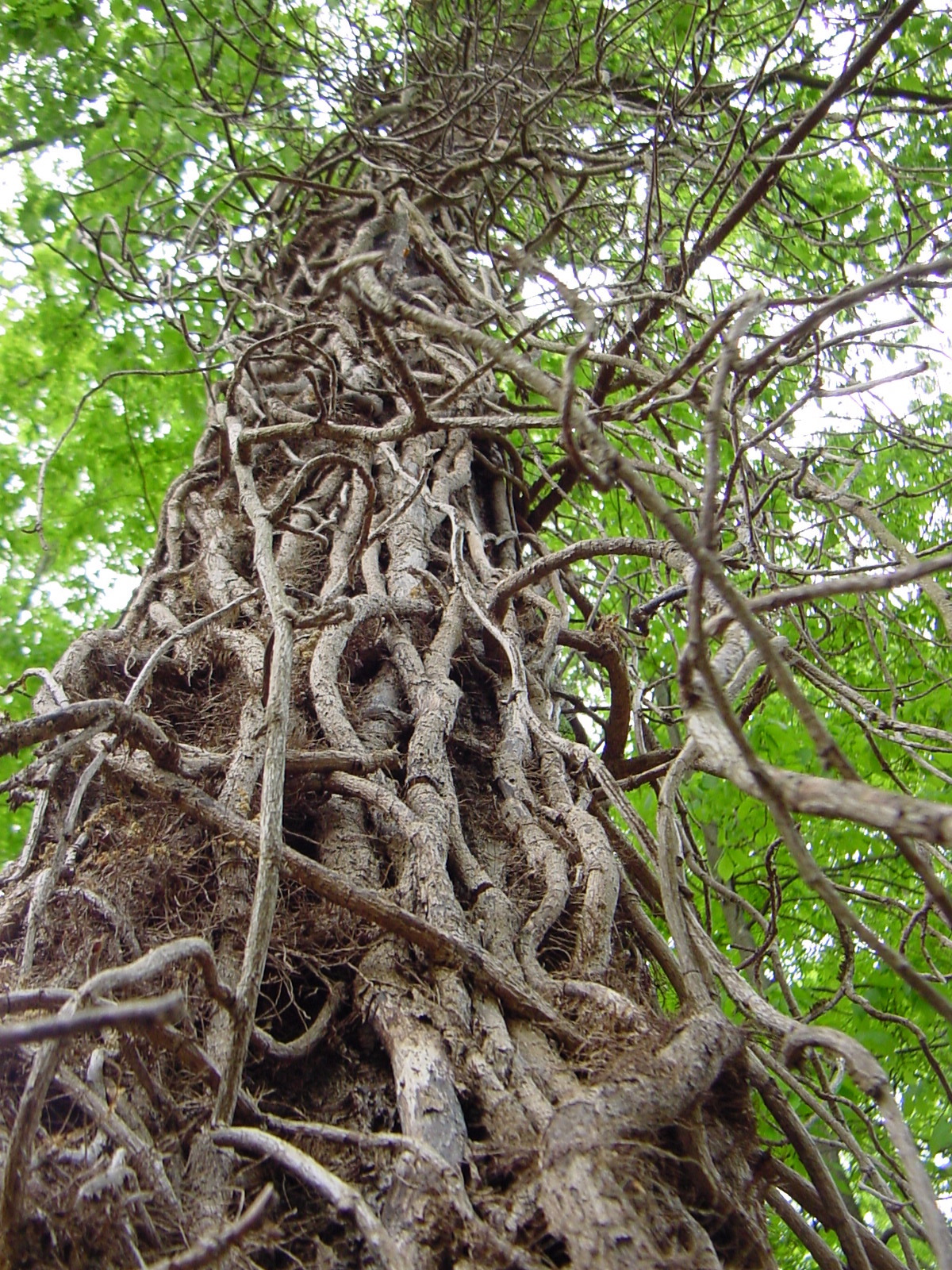 Summer foliage is the best time to spot it in a larger forest situation.  It will die just looking at Glycophosphate. Easy to kill. Here's a fun fact that is new to me - poison ivy, oak, sumac, pistachio and mango are in the cashew family of plants.  "The anacardiaceae family of trees, sometimes called the cashew family, includes mango, poison ivy, poison oak, sumac, Peruvian pepper, pistachio, and you guessed it, cashews. They all contain urushiol, the sneaky oil that causes the skin to erupt in rashes for some people and is the bane of my existence, but to varying degrees. The oil is found in all parts of the plant, including the leaves, stems, and even the roots. Urushiol is the reason cashews are never sold in the shell and are typically roasted. The oil is found on the outer shell (similar to mangos, where it’s found on the skin) and roasting the cashews at high temperatures can kill any remaining oil that makes its way through to the nut. The Center for Disease Control published a report in 1982 about a batch of >7500 bags of shell-contaminated cashews being sold in Pennsylvania and Maryland, mostly as part of a Little League fundraiser. Around 20 percent of the unlucky cashew-eaters developed a rash. Also in the family is Toxicodendron vernicifluum, or the Japanese lacquer tree. This tree produces the sap used in painting those beautiful lacquered boxes. There have been cases of rashes developing in reaction to contact with lacquerware because the oil remains in the paint." |
|
|
|
Post by 1dave on Jun 24, 2022 17:46:39 GMT -5
Who would have thunk it!
The chalice from the palace is full of malice. The flagon with the dragon contains the brew that is true!
|
|
|
|
Post by 1dave on Jun 24, 2022 19:37:14 GMT -5
Looking at the complexity of one chunk of wood hammered off of a much bigger chunk sitting on the high and dry forest floor. It broke off easily with a hammer blow at one of the many old fracture lines, that being the darker face. It appears to have no fractures, a solid section. These thin cross grain wedge and flat cross grain segments are often rich in silica and color as if these chemicals made an easy entrance thru the vascular veins running with the wood grain. Judging from the patina covered fractures this appears to be the radial annual rings of the tree. Bark side at top, center of tree at bottom. 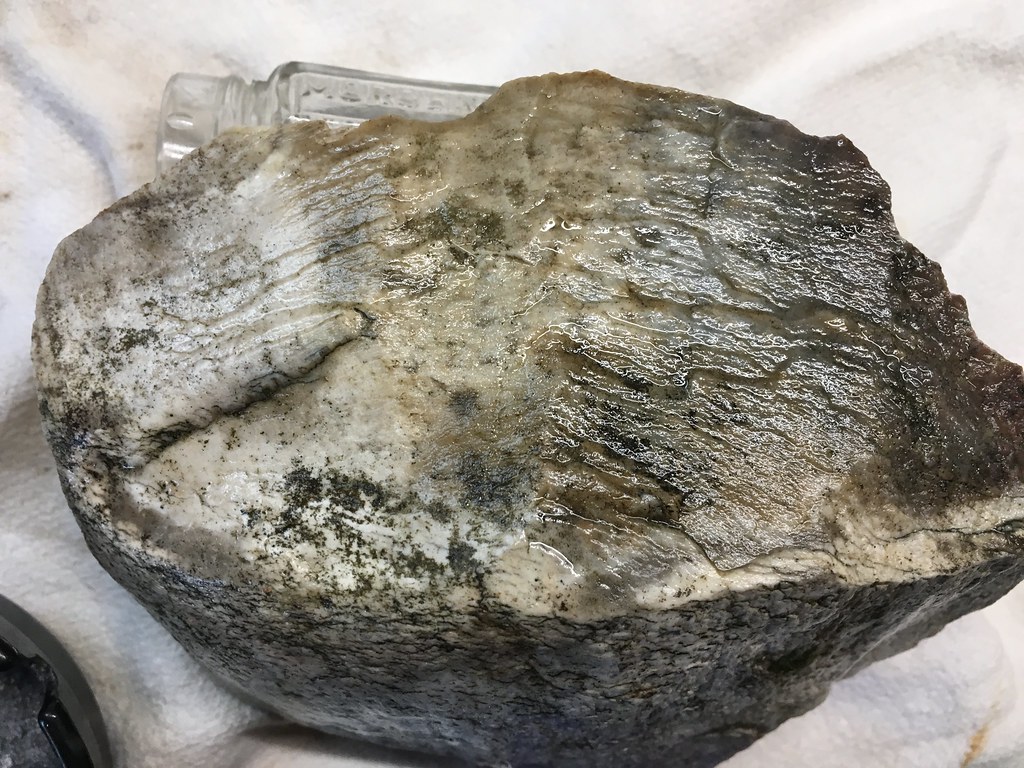 This view looking at the inside of the tree that was facing toward the sun in open air. Heavy patina. 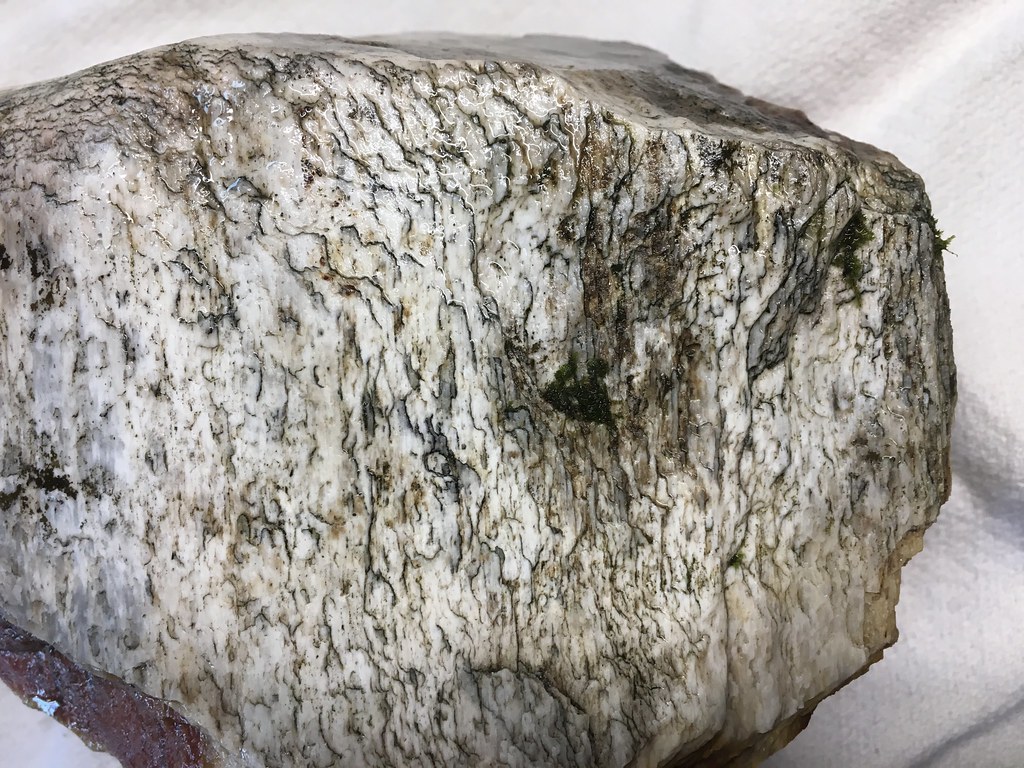 Looking at the bottom where is fractured away, all growth rings not visible. 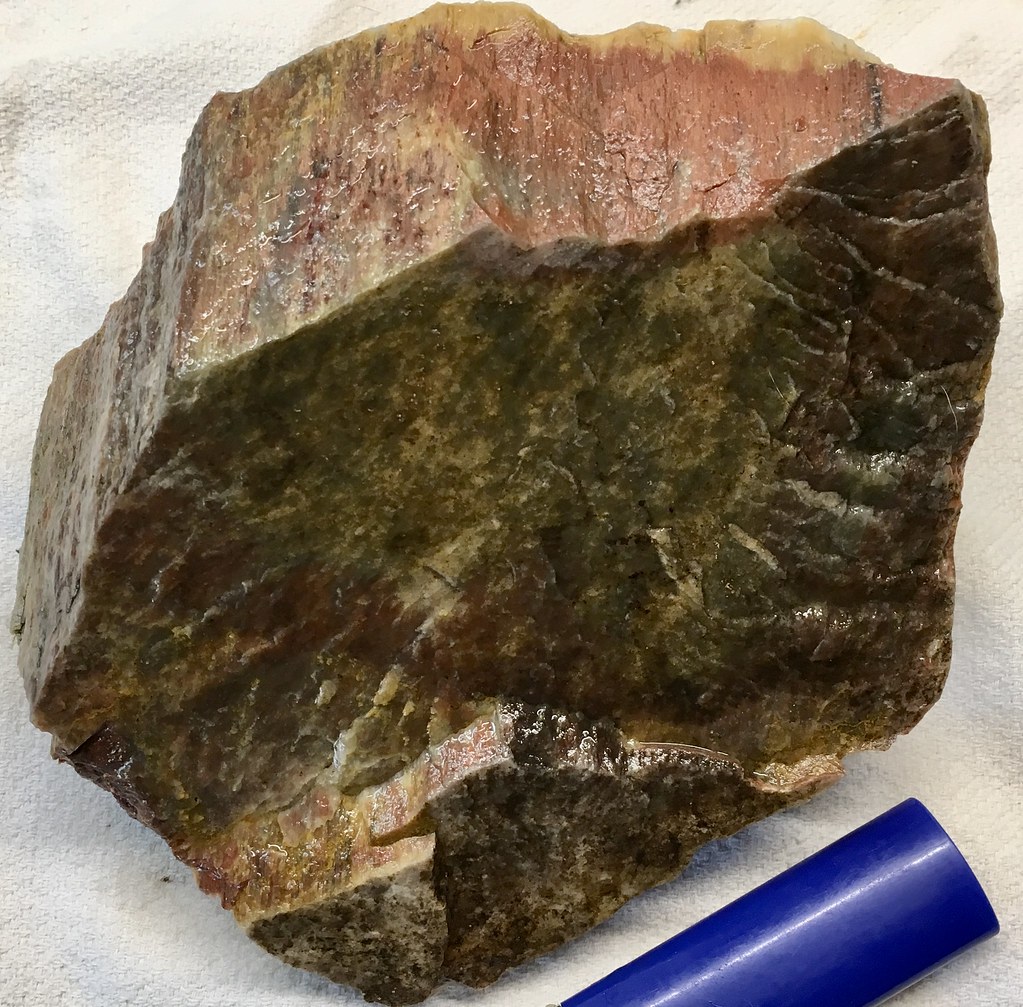 A chipped face parallel to the annual rings looking at the inside of the tree, wood grain preserved.  This chip is as if quarter sawn, perpendicular to center of tree. 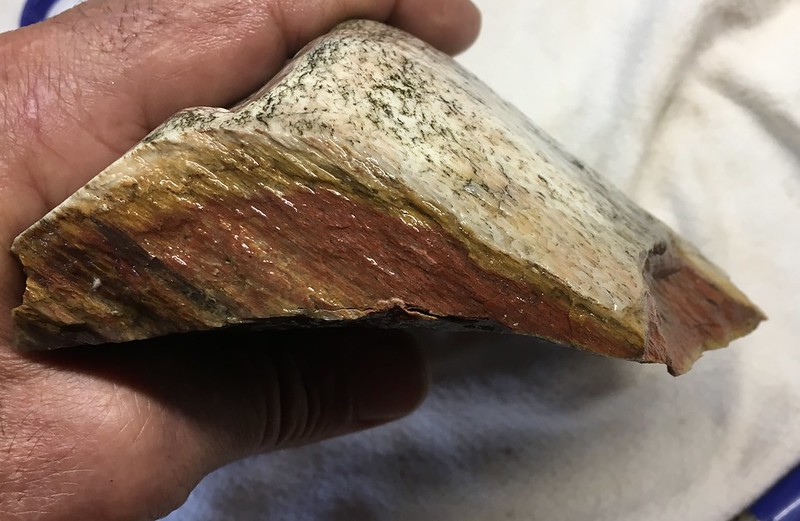 This chip is looking from the outside of the tree and is parallel to the annual growth rings.  This chip is also looking from the outside of the tree but is crossing the annual growth rings at a 30 degree angle. 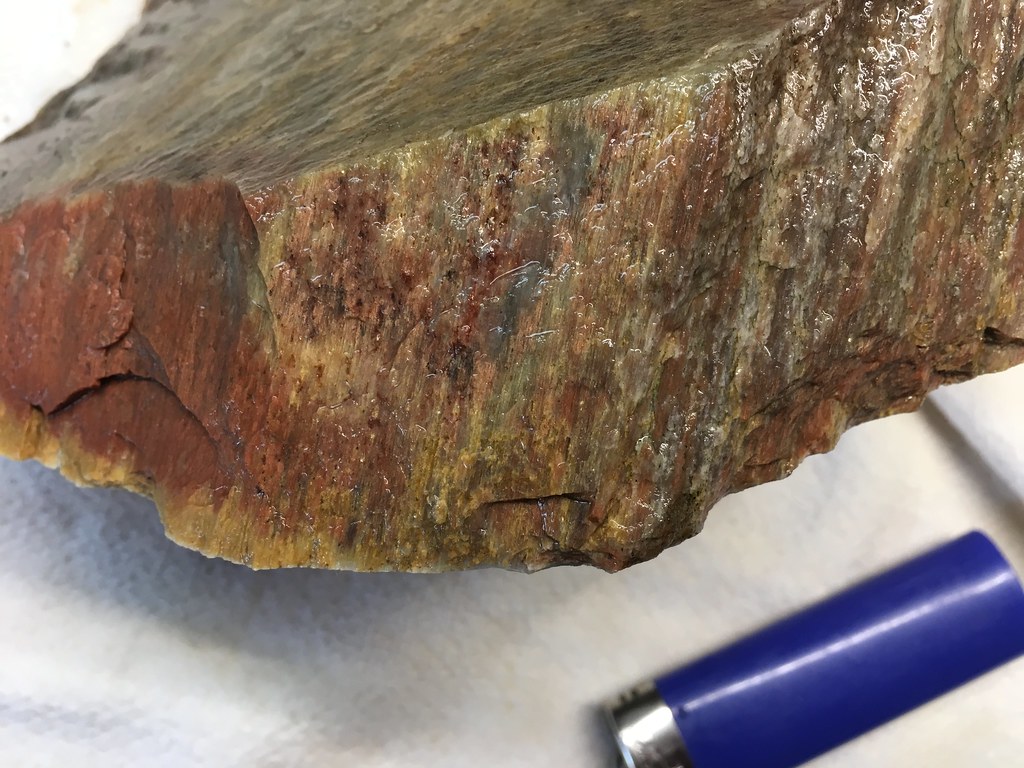 This is an older weathered radial sawn(broken) chip. Fresh chips at bottom of photo. 

And we are looking at pith instead of annular rings?  fliphtml5.com/qaug/ftdm/basic fliphtml5.com/qaug/ftdm/basic |
|
|
|
Post by 1dave on Jun 24, 2022 20:09:53 GMT -5
|
|
jamesp
Cave Dweller 
Member since October 2012
Posts: 36,570
|
Post by jamesp on Jul 8, 2022 7:09:37 GMT -5
With all that mica and schistose appearance I’m pretty sure this is quartz mica schist and not petrified wood. Mica schist can have very fine grained quartz and it’s common for some mica schist to be predominantly quartz (segregated quartz). The grains look more like bedding planes than grain/ growth rings in wood. These appear to be combination silicified sand casts and replacements. The sand washed down from the mica rich Appalachians. Even the silicified sandstone(Tallahatta Sandstone) his mica particles in it. This plant appears to be a vascular or palm and not necessarily a woody with rings. Not to far from here 10" diameter non-woody equisetum(horsetail) can be found. There is a geological article back in this thread describing the process. The map a few pages back shows the 200 mile long Coker formation where wood is common. Next to and above this formation is a metagranite/metavolcanic layer(tail of Appalachians). The volcanic ash based clay likely supplied the silica. I see your point though. Logs are common at site. |
|
jamesp
Cave Dweller 
Member since October 2012
Posts: 36,570
|
Post by jamesp on Jul 8, 2022 7:34:28 GMT -5
1dave Bravura Cabochon DesignsI am guessing these are all the same plant. Note that no specimen out of 100's has been found to have a single limb knot... Many petrifications are not wood. Especially down south and especially in Texas where over 400 fossil palm species have been ID'ed.(there are only about a dozen palm species in North America today). There were so many other species beyond cyclades, ferns, palms, etc that it is often impossible to identify the diverse plant life back then. Call it the Garden of Eden  . I picked these plant petrifications up in south Texas in a couple of weeks. There are some insane plant structures. No telling what crazy species existed back then. Most seem not to be wood or fern or cyclad, no telling what species they might be. Then you enter the distortion effects of silicification and things get real complicated. You may have the answer. The Alabama paleontologists have been challenged in making an ID. Texas petrifications of 'mystery species' and wood and palm: www.flickr.com/photos/67205364@N06/sets/72157673525247354This Texas plant resembles the plant in Alabama. I found a lot of it. It was typically red too.  Cross sawn it resembles the Alabama plant closely with the blotchy texture and no rings. 
|
|
jamesp
Cave Dweller 
Member since October 2012
Posts: 36,570
|
Post by jamesp on Jul 8, 2022 7:39:02 GMT -5
This Texas find has a unique structure 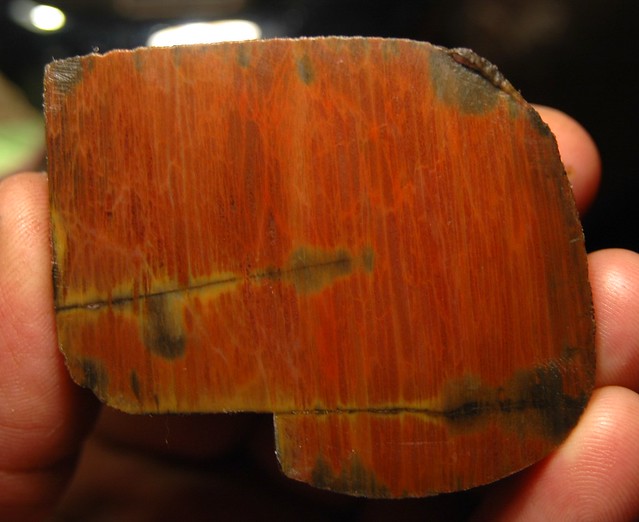 |
|
jamesp
Cave Dweller 
Member since October 2012
Posts: 36,570
|
Post by jamesp on Jul 8, 2022 7:47:05 GMT -5
Texas shinkwood or 'pocket rot'. This wood petrified after rotting and separating. Friend's finds. Remember 1dave you mention petrified rotting wood ? 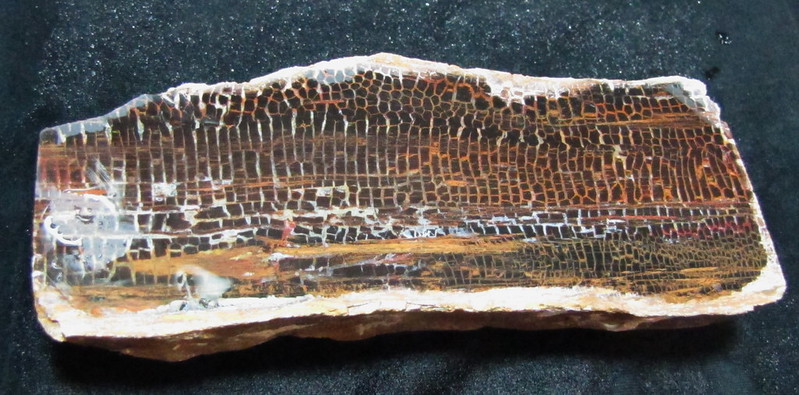  Texas shrinkwood altered by silicification process 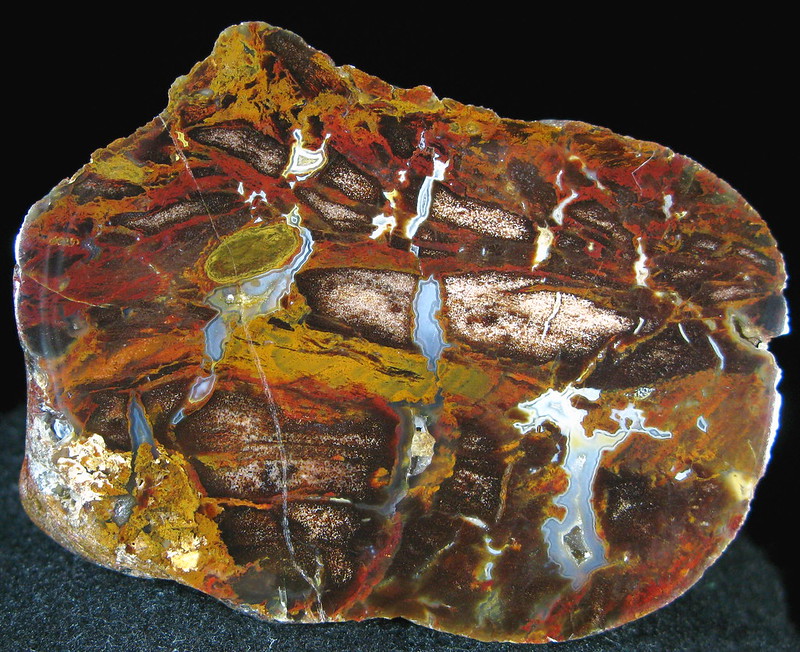 |
|
|
|
Post by 1dave on Jul 8, 2022 9:32:16 GMT -5
Impossibly Wonderful!
|
|
Sabre52
Cave Dweller  Me and my gal, Rosie
Me and my gal, Rosie
Member since August 2005
Posts: 20,487
|
Post by Sabre52 on Jul 25, 2022 15:29:25 GMT -5
Oh yeah, anyone who has not visited Darwin Dillons flickr site (Dardilrocks) and looked at is pictures is really missing something. He is the real authority on south Texas pet wood and Rio Grande agate. Visiting him at a gem show really gave me the bug that's for sure.
|
|
jamesp
Cave Dweller 
Member since October 2012
Posts: 36,570
|
Post by jamesp on Jul 25, 2022 16:09:21 GMT -5
Oh yeah, anyone who has not visited Darwin Dillons flickr site (Dardilrocks) and looked at is pictures is really missing something. He is the real authority on south Texas pet wood and Rio Grande agate. Visiting him at a gem show really gave me the bug that's for sure. One of the best agate collections on earth IMO Mel. |
|
jamesp
Cave Dweller 
Member since October 2012
Posts: 36,570
|
Post by jamesp on Jul 25, 2022 16:13:03 GMT -5
As usual, the grey sections suggest silicified sand fill with mica flecks that filled into rotted out areas. The glittery spots in the photo at the grey zones are mica fleck reflections. Suggests that the sand came from the Appalachians... 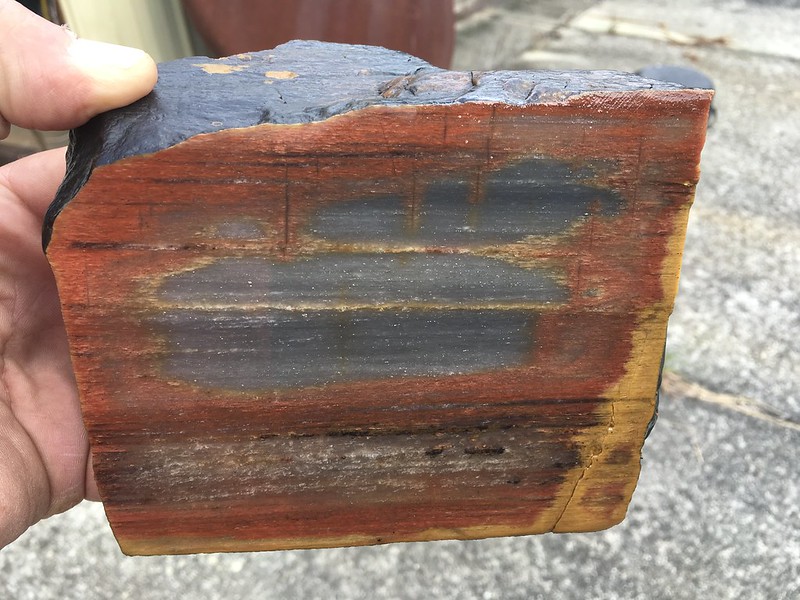 |
|
|
|
Post by liveoak on Jul 26, 2022 10:13:36 GMT -5
Is it possible that the red color is just from weathering & iron absorption from the red clay Alabama soil ?
Patty
|
|
jamesp
Cave Dweller 
Member since October 2012
Posts: 36,570
|
Post by jamesp on Jul 27, 2022 8:37:59 GMT -5
Is it possible that the red color is just from weathering & iron absorption from the red clay Alabama soil ? Patty Very possible Patty. Chemistry is nebulous at best. The geologists claim the overburden is a volcanic ash based clay layer at this local and volcanic ash is notorious for forming pet wood. So that should be considered. I don't think I see any red clay where the pet wood is if that has any bearing. This is the clay that is found with/above the wood:  This may help. My first lesson in reading geologic maps ! The yellow grooves in the Coker aquifer are creek and river cuts thru the Coker. This is the aquifer setup(glad I looked at the aquifer map). The wood is in the green Coker aquifer and the overlaying formation is the pink metavolcanic aquifer. The metavolcanic is a volcanic ash mix in clay and could have lots of iron. The Coker formation contains wood in it over its whole length; the USGS Alabama geologist informed me of this. I was excited to know all this. I never knew there was volcanic anything in the SE US !  |
|
|
|
Post by liveoak on Jul 27, 2022 9:13:16 GMT -5
Interesting jamesp , maybe it sucked all the red out of the clay 
Seriously - what you're saving is that the grayish clay, where the wood is found, has a lot of iron content, even though it's not red color ? One of life's great mysteries
Patty.... hoping you're feeling & healing better .
|
|
jamesp
Cave Dweller 
Member since October 2012
Posts: 36,570
|
Post by jamesp on Jul 27, 2022 13:08:43 GMT -5
|
|
|
|
Post by RickB on Sept 8, 2022 6:54:33 GMT -5
jamesp I can imagine that you are teething at the bit to get back into action when it gets cooler this fall and you are feeling much better.
|
|
jamesp
Cave Dweller 
Member since October 2012
Posts: 36,570
|
Post by jamesp on Sept 14, 2022 10:58:53 GMT -5
jamesp I can imagine that you are teething at the bit to get back into action when it gets cooler this fall and you are feeling much better. Hi Rick. All has been well. I was down for a few weeks but got back to most activities after that. This farm keeps me busy at times and we had two bathroom to finish up with the help of contractors. You would like this, earlier this year I mapped and drove poles around a 50' x 20' section of an exposed camp at low water that always has 3 to 4 inches of silt sitting on it at Lake Wheeler(N Alabama) during winter drawdown. During the warm season this mucked over section of the camp maintains about 20 inches of water on top of it. The muck is pasty to hard during the winter when exposed, but turns soft when covered with the water. By sitting in the warm summer water and working your fingers thru the 4 inch thick muck the hardpan under it is covered with a layer of small rocks and a large amount of knapping chips. About every 3'x 3' a point is found under that muck since artifact collectors can't see them. They are Elk River spearhead points and are real easy to 'feel' in the mix of rocks and chips because they are 3 to 5 inches long and wicked well made. About 20 years ago Denise and I took a pump in the canoe and (illegally before the silting laws were so strict)washed a 20' x 20' section of the silt off this camp and found 40 fine spearheads in about 4 hours. No doubt the camp is loaded with unfound points. Working at least 20' X 50' by hand will take a while. The mucked over section of the camp could be as large as 200' x 30'. If this 'theory/technique' works and there is a large quantity of points I'll be asking more people to go and we will have blast extracting a bunch of fine points since the more the merrier on such an adventure. I just need to go up there and give this gig a try. |
|
|
|
Post by RickB on Sept 14, 2022 13:13:55 GMT -5
jamesp Good luck on your adventure. If you had to guess, who would get the "dirty digger award" when mucking/mudlarking a site like that - you or Denise?
|
|
|
|
Post by pebblesky on Sept 15, 2022 18:08:06 GMT -5
This thread is as marvelous as educational. I enjoy the reading very much. Thanks for sharing with us your eye-opening journey(s)!
|
|





















 .
.















